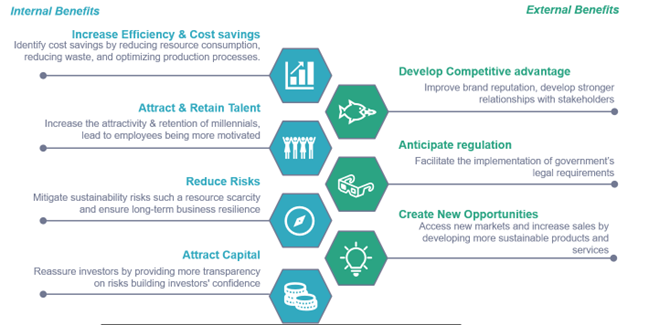Our recent experience in accompanying companies in their first reporting exercise under the Corporate Sustainability Reporting Directive (CSRD) taught us it is resource-intensive, involving detailed data collection, documentation, and compliance checks.
However, CSRD goes beyond being a mere regulatory checkbox; it also serves as a strategic opportunity. It allows companies to (re)define their corporate sustainability strategy and to embed sustainability into their culture and business operations.
Conducted with sufficient quality and credibility, CSRD reporting can build investor confidence and position companies for sustainable growth.
Fostering sustainability to live in the company
CSRD challenges companies to adopt a long-term perspective, particularly for climate and energy-related matters. For instance, the directive encourages forward-looking analyses, such as stress tests and climate-related scenarios, to prepare businesses to anticipate potential future challenges. This approach helps companies develop strategies that are resilient to environmental changes and regulatory shifts, ultimately supporting sustained business growth.
By understanding potential risks and opportunities, companies can adapt their business models to meet evolving regulatory requirements and market demands. A focus on long-term resilience enhances decision-making and positions companies to thrive in an increasingly sustainability-driven market.
Once a sustainability strategy and vision are set, CSRD reporting requires input from multiple departments, including operations, finance, HR, and procurement necessitating clear communication and coordinated efforts. This multi-departmental involvement underscores the need for employee awareness and internal communication to ensure all team members understand their roles and contributions toward the company’s sustainability goals.
However, experience often reveals that many employees across various levels of the organization are unaware of their company’s sustainability policies, goals, or progress or how they can contribute to it. This lack of awareness hinders collective action and alignment toward sustainability objectives.
Effective Change Management and clear communication about the company’s sustainability ambitions, progress, and the relevance of sustainability for the company long-term goals can inspire employees to take ownership and contribute to this vision, while also attracting new talents or retaining current employees. Transparent internal communication also ensures that employees understand the purpose and impact of CSRD and how they can contribute to it within their roles. The level of transparency mandated by CSRD fosters cross-departmental alignment, ensuring that sustainability goals are integrated into the organization’s overall business model rather than being treated as standalone objectives. Effective internal communication along the whole change journey ensures these teams work together seamlessly to gather data, identify risks, and implement sustainability initiatives.
Therefore, there are different ways to organize roles and responsibilities related to sustainability implementation, but what matters most is having clear governance. There are different practices observed in the market. Often, the role of the ESG team is to support their colleagues by translating regulatory requirements into actionable practices and to challenge the ambition of the actions in place, provide insights on best practices and oversee the performance and progress of the initiatives.
Nevertheless, the CSRD compels companies to upskill their teams by integrating some Environmental, Social, and Governance (ESG) knowledge into their training programs, extending beyond just the ESG teams or sustainability specialists. True innovation does not rest solely with ESG specialists. Operational experts, with their deep domain expertise, play a crucial role in uncovering innovative, sustainable solutions.
By fostering transparency, engaging employees, and aligning teams across departments, CSRD drives a cultural shift toward sustainability. Effective internal communication ensures that everyone within the organization understands their role in achieving ESG goals.
Business Efficiency and risk management create new opportunities
CSRD’s rigorous reporting requirements push companies to improve data management and documentation. The reporting requires a need for great data granularity across many topics. Companies should therefore assess their data collection tools and processes to ensure they can comply.
Monitoring performance may increase efficiency that can lead to leaner and cost-efficient processes. For instance, a manufacturing firm might streamline production lines or minimize material waste, resulting in significant cost savings. In addition, by obliging companies to transparently disclose their sustainability practices, including aspects of their supply chain and due diligence processes, the CSRD helps lay the groundwork for the upcoming Corporate Sustainability Due Diligence Directive.
Enhanced monitoring can reveal critical gaps in operational resilience, such as over-reliance on a few suppliers or vulnerability to resource shortages. Addressing these gaps strengthens business continuity and reduces exposure to risks.
Thanks to CSRD, companies integrate non-financial risks into their risk management frameworks. This broader perspective supports business efficiency by addressing ESG-related risks and opportunities alongside traditional financial concerns.
Better data management supports better decision making, to optimize operations. By considering the interconnections between financial, social, and environmental factors, CSRD promotes holistic decision-making that drives long-term efficiency and resilience.
All those internal benefits will allow the company to develop a competitive advantage, while creating new business opportunities. A company that can demonstrate effective risks management, efficient processes, enhanced resilience and strong governance fosters trust among investors. A good CSRD report can therefore also make the company more attractive as a reliable and sustainable destination for capital.
Key takeaways
CSRD is not just about compliance; it is a driver of transformation. By upskilling employees to embed sustainability in the company culture, optimizing resource use, integrating ESG risks, and thereby fostering long-term resilience, the directive pushes companies to rethink their strategies and redefine their business models.
While the initial reporting process may be demanding, the benefits, both internal and external—efficiency, innovation, transparency, opportunities, talent attraction and resilience—far outweigh the challenges.
Companies that embrace CSRD as an opportunity rather than a burden will emerge stronger, more competitive, and better equipped for a sustainable future.
